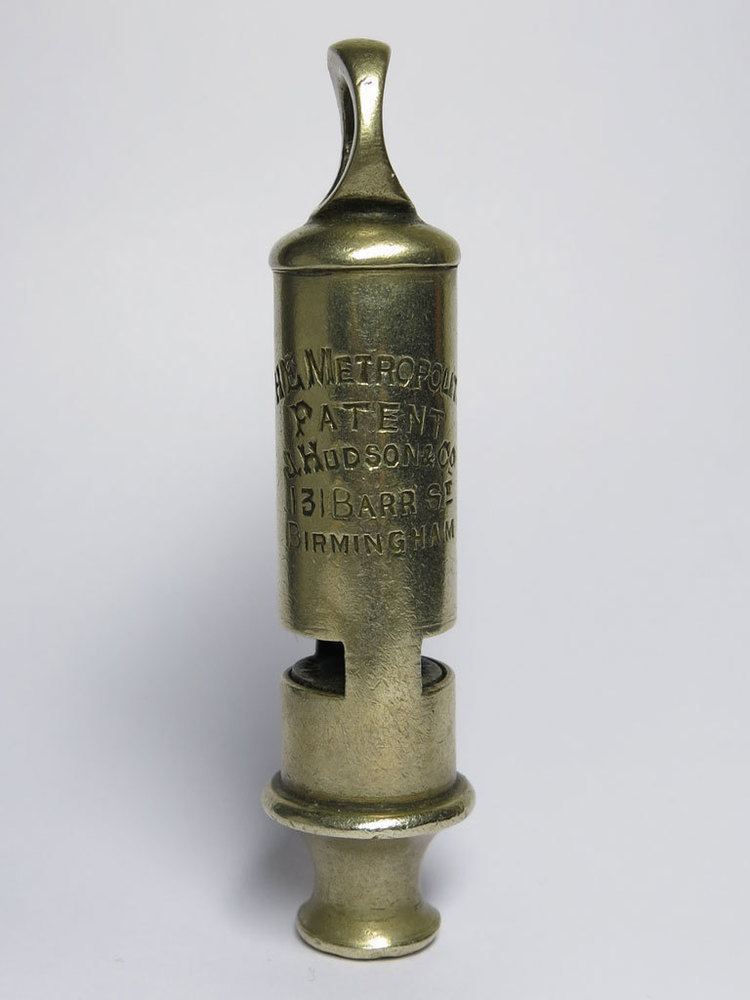Industry Manufacturing Revenue 5 million GBP (2005) Website www.acmewhistles.co.uk Type of business Private | Products Whistles Number of employees ~100 | |
 | ||
Key people Joseph Hudson, FounderSimon Topman, managing director Founded 1883, Birmingham, United Kingdom | ||
J Hudson & Co was founded in the 1870s in Birmingham by Joseph Hudson (1848–1930) and his brother James Hudson (1850–1888). The company became a manufacturer of whistles and continues as Acme Whistles. Acme is the world’s largest and most famous producer of whistles. They are headquartered in the Jewellery Quarter district of Birmingham, England.
Contents
History
The company was family-run for over 100 years and three generations; Joseph Hudson's son, James Clifford Hudson and his grandson, Leon Clifford Hudson ran the company after Joseph retired. As of 2014 Acme Whistles, is owned and managed by Simon Topman.
1883–1908
Joseph Hudson started working at the age of 12. He moved to Bent & Parker, a maker of army supplies and whistles in Birmingham. In 1870, aged 22, he started his own business with younger brother James.
In 1883 Hudson began tinkering in his toolshed to make gadgets to sell, including whistles. After observing local police struggling to communicate with rattles, he realised that his whistle could be used as a tool. As the story goes, Hudson, a violin player, accidentally dropped his violin and it shattered on the floor. Observing how the discordant sound of the breaking strings travelled, Hudson had the idea to put a pea in the whistle. This gave it an ear splitting rattle that could grab attention even a mile away. After a demonstration at Scotland Yard, Hudson had his first sale.
This 1884 contract with the police gradually made Hudson the largest whistle manufacturer for British Empire police forces, military, sports, railways and many others. By the 1890s, Hudson faced the rise of many competitor makers and companies.
Highlights of early company history include:
By 1908, Hudson and De Courcy were the two major whistle makers in England.
1909–1930
Starting 1909 at a new facility in northern Birmingham at 244 Barr St., Hudson expanded to more markets in Europe and overseas, with an office in Paris, a large 1910 French catalogue, and new connections with United States sporting goods companies and distributors. Hudson was left with just one British competitor, A De Courcy & Co, from 1909 to 1927.
In 1927 Hudson purchased A De Courcy's patent rights, tools and stock. Hudson became the world's largest maker, gaining the Thunderer Registered Trademark. The Acme Thunderer whistle and its variations became the world's best-selling whistle.
During this period, 1925 to 1930, three generations of the Hudson family ran the business together. This was the end of the golden age of whistle making.
1930–2000
At the beginning of this period the company faced competition from whistles made of tin, plastic and cast base metal materials made in Germany, Japan, USA and other countries.
On 26 October 1940, the factory received a direct hit from a German air raid. No one was injured, but the factory suffered major damage. Air Raid Precautions whistles were made during the next few years and dated whistles for army, navy and Royal Air Force equipment and for Civil Defence.
In 1949 the firm was re-constituted as J. Hudson & Co. (Whistles) Ltd. Leon C. Hudson became its first managing director.
The 1950s and 60s marked growing demand for Hudson sports whistles, Olympics and other sport events on five continents.
In 1957 A. R. Topman became an assistant general manager, and about 40 years later his son, Simon Topman, became the owner and the managing director of the company, starting the fourth period of company developments.
2000–present
The factory name was changed to Acme Whistles and makes about 5 million whistles each year. It continues to register new patents for whistles. The period was marked with growing competition from far east and Chinese manufacturers.
They have made over a billion whistles altogether. In addition to the "Thunderer", they make varieties of bird calls, dog calls, safety whistles, sports whistles and party whoopers.
Patents, registered designs and trademarks
Registered Designs
Registered Trademarks
Catalogues
Models and whistle types
While many makers concentrated on limited variety, J Hudson & Co made a wide variety of common whistle types, including bird calls, dog calls, fox calls and musical whistles as well as sound effects, slide whistles and novelty combination whistles. Some models, such as the Thunderer Escargot-type and the Metropolitan general service whistle have been popular throughout most of the company's history.
Hudson was the only maker in the United Kingdom to use wood horn, Bakelite, plastic and silver, while competitors other than James Dixon & Sons were working solely with metal or other materials.
Body stamps
Hudson stamped addresses and other marks on many of its whistles. Marked service whistles have been used by many police forces, railway companies, fire brigades and other organisations. The stamps supply an easy tool for dating the item. Address stamps are more commonly found on the GSWs than other types. Notable body stamps include:
